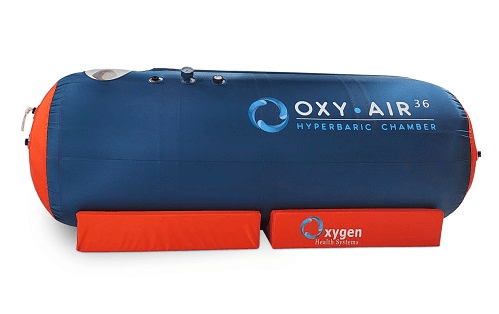Off-Gassing and Its Impact on Hyperbaric Oxygen Therapy Chambers

In this article where we will explore the concept of off-gassing and its relevance to Hyperbaric Oxygen Therapy (HBOT) chambers.
Off-gassing is the discharge of volatile organic compounds (VOCs) from materials and products, which can have negative health consequences on humans.
Understanding off-gassing in HBOT chambers is critical because it directly impacts the environment in which patients are exposed to high-pressure oxygen.
What is Off-Gassing and Its Potential Health Effects
The release of VOCs (Volatile Organic Compounds) or other compounds from materials into the surrounding air is referred to as off-gassing.
When things are made, they frequently contain chemicals that slowly evaporate over time, creating fumes or vapors. [1]
These volatile compounds, which can include:
- formaldehyde
- benzene
- toluene
- xylene and others
These chemicals can cause problems with health to those who are exposed to them. Long-term VOC exposure can cause symptoms such as:
- eye, nose, and throat irritation,
- headaches
- dizziness
- nausea, and,
- in extreme cases, respiratory difficulties. [2]
Understanding and regulating off-gassing is therefore critical for creating a safe environment for patients.
Off-Gassing vs. Outgassing
Before we go any further, it’s crucial to know the difference between off-gassing and outgassing. Although these names are frequently used interchangeably, there is a subtle difference between them.
Off-gassing is the discharge of chemicals from new or produced objects, whereas outgassing is the emission of gases from materials such as metals, polymers, or composites during high-temperature procedures such as welding or manufacturing.
In this article we are going to concentrate on off-gassing in the context of HBOT chambers, which is the emission of VOCs from the chamber’s components.
Soft-shell Hyperbaric Oxygen Therapy Chambers Materials
Soft-shell HBOT chambers are widely used in clinical settings to deliver pressurized oxygen therapy, offering a non-invasive and comfortable experience for patients. They are usually the preferred HBOTs for home use.
Unlike their rigid (Hard-shell HBOTs) counterparts, these chambers are designed with flexibility in mind, allowing for easy installation and enhanced patient comfort.
Read Also: Hard vs Soft Hyperbaric Chambers: How Do They Compare?
But what materials are these chambers made of, and why do manufacturers opt for a soft-shell design?
Manufacturers use a variety of materials, each with its own set of features. For example, most soft-shelled manufacturers use:
- Polyurethane (PU), a versatile polymer noted for its strength, flexibility, and abrasion resistance, is one regularly used substance. PU materials have the required toughness and suppleness to support patient movement inside the chamber while maintaining a dependable seal.
- Thermoplastic polyurethane (TPU) is another material option that combines the greatest qualities of plastic and rubber. TPU materials are appropriate for soft-shell HBOT chambers due to their great tear resistance, high tensile strength, and remarkable flexibility.

Off-Gassing in HBOT Chambers
When selecting materials for HBOT chambers, not all manufacturers use the same level of quality control.
Some manufacturers may choose to use less expensive materials that are more likely to off-gas.
Low-grade PU or TPU textiles with high quantities of volatile compounds may be among these materials.
When these materials are subjected to high-pressure oxygen in the chamber, their off-gassing can be expedited, thereby increasing the hazards to patients.
Off-gassing is an issue in HBOT chambers because patients spend a lot of time within these chambers, typically inhaling in concentrated oxygen. If the chamber materials emit volatile compounds, it can have a major influence on the therapeutic environment’s quality.
Manufacturers who value patient safety and strive to reduce off-gassing concerns choose their materials with care.
They use high-quality, medical-grade materials with low VOC levels that have been tested and verified. These materials are intended to reduce off-gassing while prioritizing patient well-being.
Oxygen Health Systems is one example of a manufacturer that values patient safety. They make use of materials like Medical Grade Durable PET Polyester Embodied TPU, which is well-known for its non-toxic medical-grade qualities.
This material was chosen expressly to reduce off-gassing and offer a safe atmosphere for patients.
Furthermore, they guarantee that their chambers are free of phthalates, which are a class of chemicals that are typically connected with off-gassing and have been linked to potential health problems.
You can find their Hyperbaric Oxygen Therapy Chambers on their websites HyperbaricPRO and Oxygen Health Systems.
Bottom Line
Finally, here’s what you need to remember from this article:
- Off-gassing is the emission of volatile organic compounds (VOCs) or other chemicals into the surrounding environment from materials.
- Individuals exposed to these substances may have symptoms such as eye, nose, and throat irritation, headaches, disorientation, and more serious respiratory difficulties.
- The selection of chamber materials is critical when it comes to Hyperbaric Oxygen Therapy (HBOT) chambers. You may want to check our article on How To Choose a Hyperbaric Oxygen Chamber.
- Manufacturers must emphasize patient safety by selecting materials that do not off-gas or off-gas only minimally. They establish a safe atmosphere for patients having HBOT therapy by utilizing high-quality, medical-grade textiles and avoiding cheaper materials that are prone to off-gassing.
- Oxygen Health Systems is one producer that uses non-toxic, medical-grade materials to assure patient safety.
Remember, off-gassing can be managed and minimized, and with the right selection of materials, HBOT chambers can provide a safe and beneficial environment for patients seeking the benefits of hyperbaric oxygen therapy.

